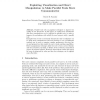Free Online Productivity Tools
i2Speak
i2Symbol
i2OCR
iTex2Img
iWeb2Print
iWeb2Shot
i2Type
iPdf2Split
iPdf2Merge
i2Bopomofo
i2Arabic
i2Style
i2Image
i2PDF
iLatex2Rtf
Sci2ools
PARA
1998
Springer
1998
Springer
Exploiting Visualization and Direct Manipulation to Make Parallel Tools More Communicative
Parallel tools rely on graphical techniques to improve the quality of user interaction. In this paper, we explore how visualization and direct manipulation can be exploited in parallel tools, in order to improve the naturalness with which the user interacts with a parallel tool. Examples from recent tool research demonstrate that tool displays can be made more communicative and more intuitive to use. Visualization methods can be used to organize complex performance data into layers and perspectives that exploit the user's visual searching capabilities. Direct manipulation techniques allow the user to focus on key elements and then transition smoothly to further levels of detail or interrelated aspects of program behavior. Heuristics derived from studies with parallel users are proposed for when and how the techniques can be applied more e ectively.
Related Content
| Added | 06 Aug 2010 |
| Updated | 06 Aug 2010 |
| Type | Conference |
| Year | 1998 |
| Where | PARA |
| Authors | Cherri M. Pancake |
Comments (0)

